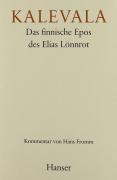Kalevala

Das finnische Epos des Elias Lönnrot
Anyone who has a passion for the Kalevala has had to contend with the hardships of a difficult contextualization of the text. With the only exception of the extraordinary but outdated book by Domenico Comparetti (1891), almost all the critical works carried out on the Kalevala, starting from the now classic studies by Kaarle Krohn, Martti Haavio and Matti Kuusi, are difficult to find and consult. In his splendid "guide" to the reading of the Kalevala, the Ugrofinnist Hans Fromm, former German translator of the poem, reveals the invisible weaving woven at the base of the great Finnish épos, the very fine chisel work with which Elias Lönnrot selected, in the immense corpus of Finnish popular poetry, the most fruitful passages and the most appropriate formulas, and allows us to recognize, beneath the passionate plot of the poem, the dense "mosaic" of thousands and thousands of verses which, skilfully set Lönnrot, have come to compose the powerful symphony of the Finnish spirit, the fresco of the origins and customs of the people, authentic compass of the national awakening of Finland. Dissolving the complex stratification of the original runolaulut, Fromm identifies the Christian elements, distinguishes the Hanseatic contaminations from the Viking contributions, and finally lays bare the roots that sink into the Balto-Finnic prehistory, dominated by shamanism and hunters' cults. It makes us flash, behind the enigmatic image of the sampo and the icy expanses of Pohjola, the conceptions of the Sámi, the Uralic mythologies, the cosmological scaffolding of the Altaic peoples. With the expertise of the linguist, the attention of the literary critic and the passion of the historian of religions, Fromm gives us, with this book, an indispensable "map" for anyone who wants to orient themselves in the jagged geology of the poem, among the infinite interpretations that give the Kalevala a timeless charm.